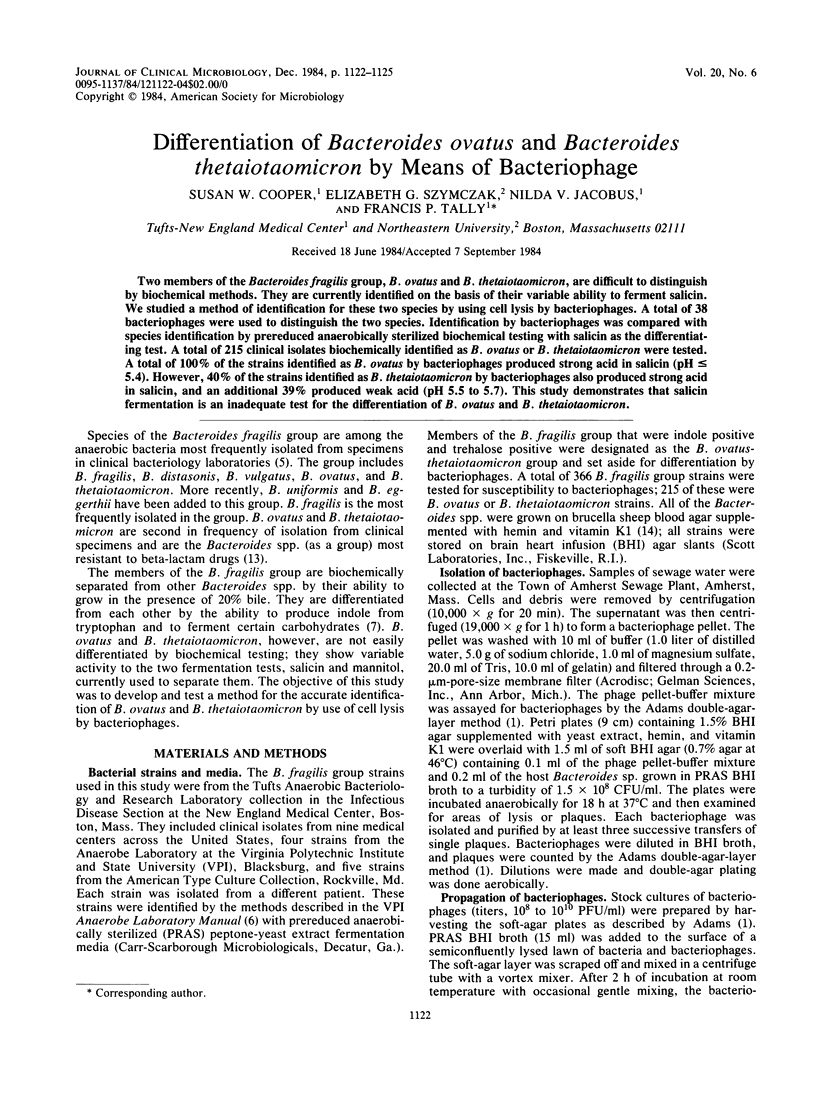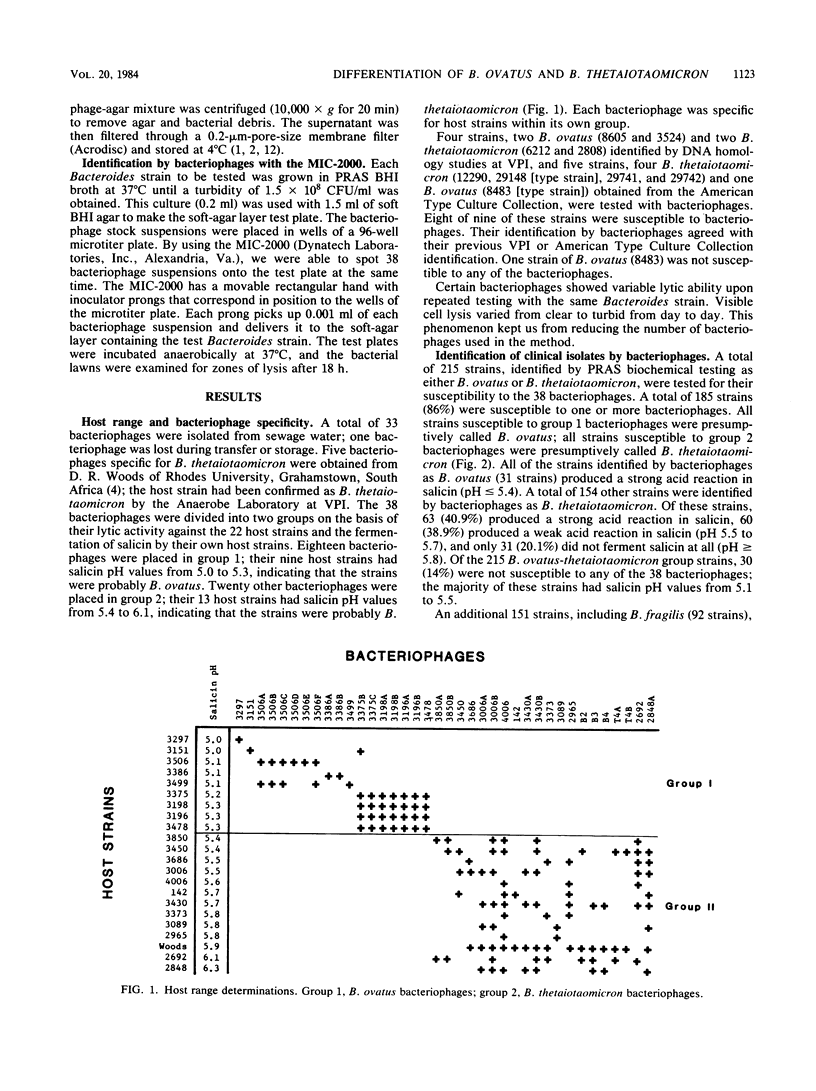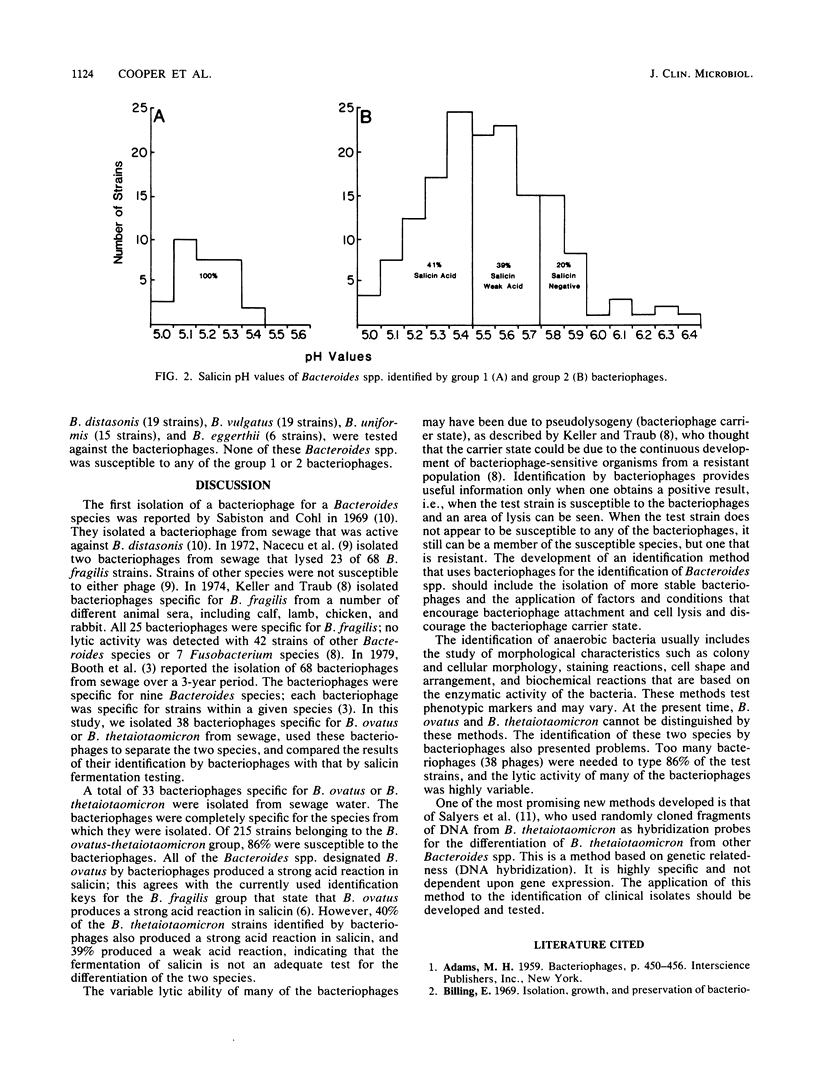Abstract
Two members of the Bacteroides fragilis group, B. ovatus and B. thetaiotaomicron, are difficult to distinguish by biochemical methods. They are currently identified on the basis of their variable ability to ferment salicin. We studied a method of identification for these two species by using cell lysis by bacteriophages. A total of 38 bacteriophages were used to distinguish the two species. Identification by bacteriophages was compared with species identification by prereduced anaerobically sterilized biochemical testing with salicin as the differentiating test. A total of 215 clinical isolates biochemically identified as B. ovatus or B. thetaiotaomicron were tested. A total of 100% of the strains identified as B. ovatus by bacteriophages produced strong acid in salicin (pH less than or equal to 5.4). However, 40% of the strains identified as B. thetaiotaomicron by bacteriophages also produced strong acid in salicin, and an additional 39% produced weak acid (pH 5.5 to 5.7). This study demonstrates that salicin fermentation is an inadequate test for the differentiation of B. ovatus and B. thetaiotaomicron.
Full text
PDF



Selected References
These references are in PubMed. This may not be the complete list of references from this article.
- Booth S. J., Van Tassell R. L., Johnson J. L., Wilkins T. D. Bacteriophages of Bacteroides. Rev Infect Dis. 1979 Mar-Apr;1(2):325–336. doi: 10.1093/clinids/1.2.325. [DOI] [PubMed] [Google Scholar]
- Burt S., Meldrum S., Woods D. R., Jones D. T. Colonial variation, capsule formation, and bacteriophage resistance in Bacteroides thetaiotaomicron. Appl Environ Microbiol. 1978 Feb;35(2):439–443. doi: 10.1128/aem.35.2.439-443.1978. [DOI] [PMC free article] [PubMed] [Google Scholar]
- Keller R., Traub N. The characterization of Bacteroides fragilis bacteriophage recovered from animal sera: observations on the nature of bacteroides phage carrier cultures. J Gen Virol. 1974 Jul;24(1):179–189. doi: 10.1099/0022-1317-24-1-179. [DOI] [PubMed] [Google Scholar]
- Nacescu N., Brandis H., Werner H. Isolierung von zwei Bacteroides fragilis-Phagen aus Abwasser und Nachweis lysogener B. fragilis-Stämme. Zentralbl Bakteriol Orig A. 1972 Apr;219(4):522–529. [PubMed] [Google Scholar]
- SWANSTROM M., ADAMS M. H. Agar layer method for production of high titer phage stocks. Proc Soc Exp Biol Med. 1951 Nov;78(2):372–375. doi: 10.3181/00379727-78-19076. [DOI] [PubMed] [Google Scholar]
- Sabiston C. B., Jr, Cohl M. E. Bacteriophage virulent for species of the genus Bacteroides. J Dent Res. 1969 Jul-Aug;48(4):599–599. doi: 10.1177/00220345690480042101. [DOI] [PubMed] [Google Scholar]
- Salyers A. A., Lynn S. P., Gardner J. F. Use of randomly cloned DNA fragments for identification of Bacteroides thetaiotaomicron. J Bacteriol. 1983 Apr;154(1):287–293. doi: 10.1128/jb.154.1.287-293.1983. [DOI] [PMC free article] [PubMed] [Google Scholar]
- Tally F. P., Cuchural G. J., Jacobus N. V., Gorbach S. L., Aldridge K. E., Cleary T. J., Finegold S. M., Hill G. B., Iannini P. B., McCloskey R. V. Susceptibility of the Bacteroides fragilis group in the United States in 1981. Antimicrob Agents Chemother. 1983 Apr;23(4):536–540. doi: 10.1128/aac.23.4.536. [DOI] [PMC free article] [PubMed] [Google Scholar]


